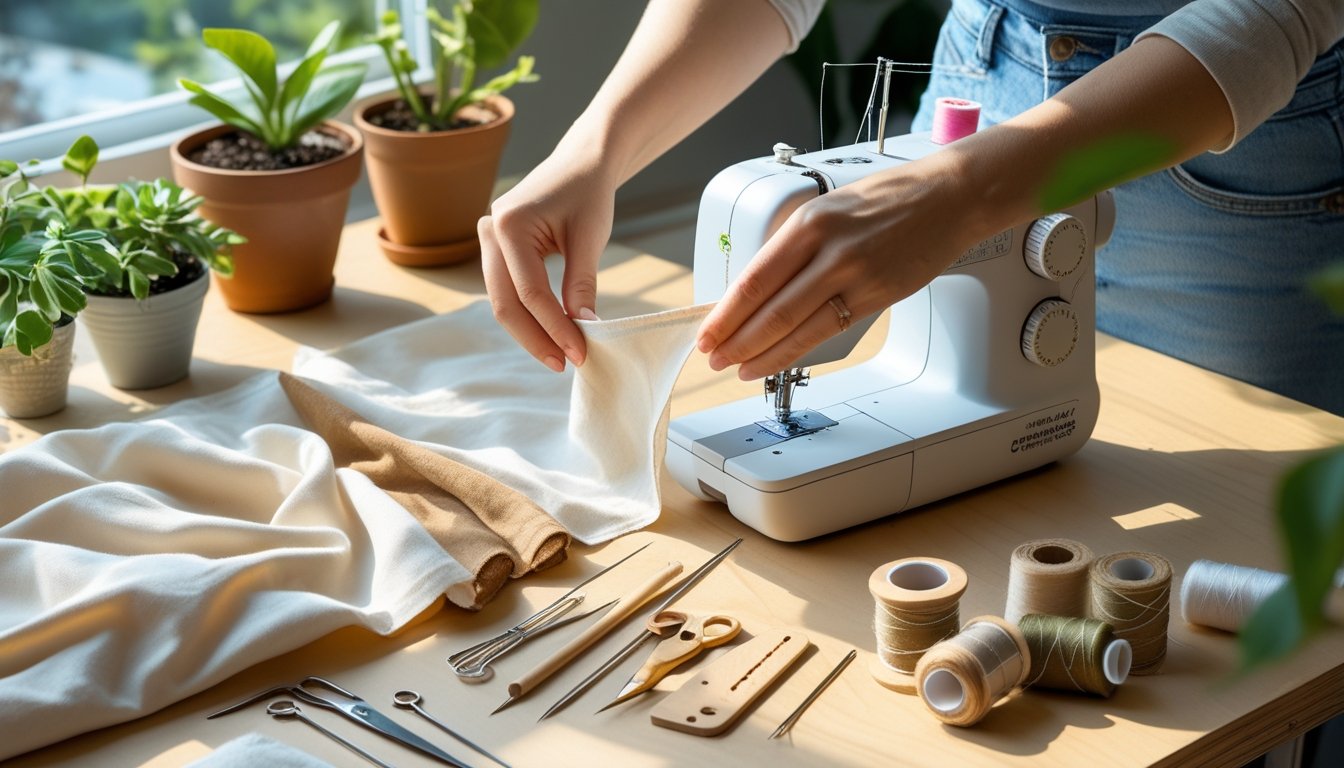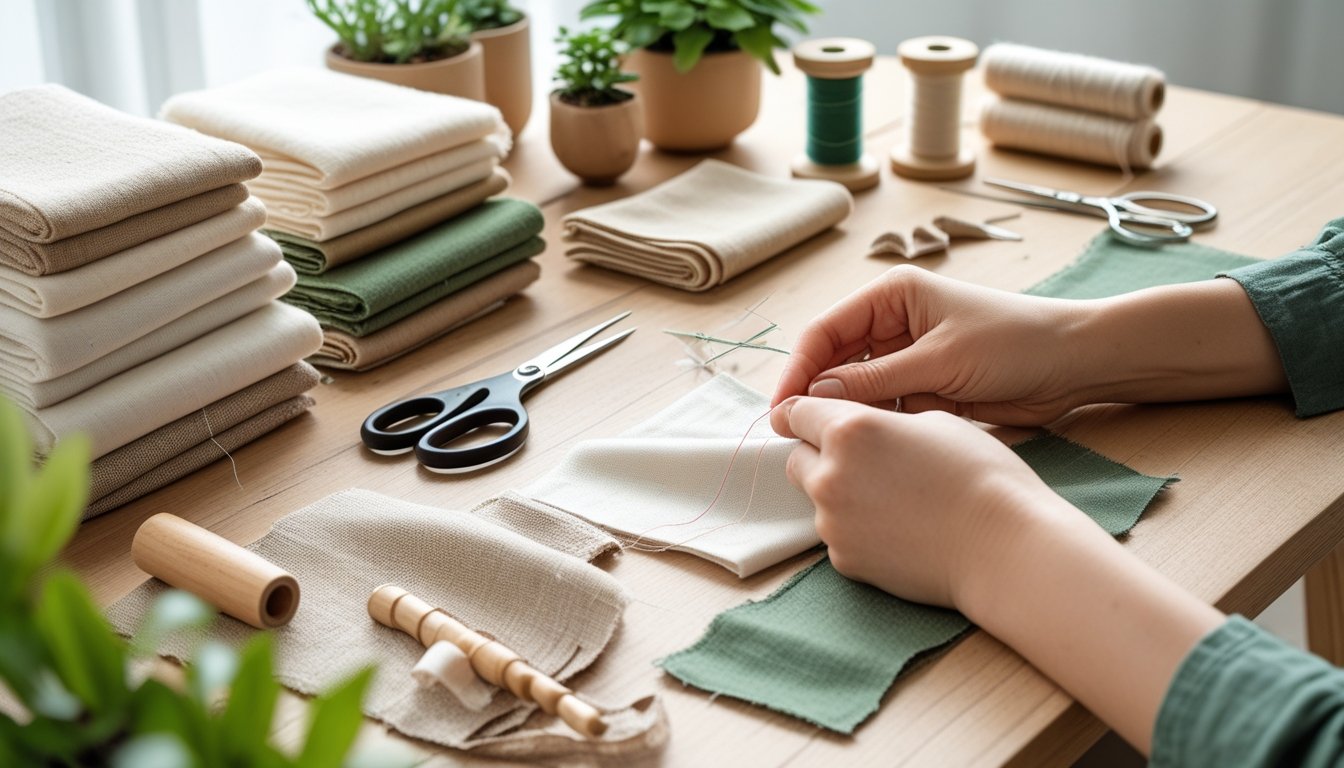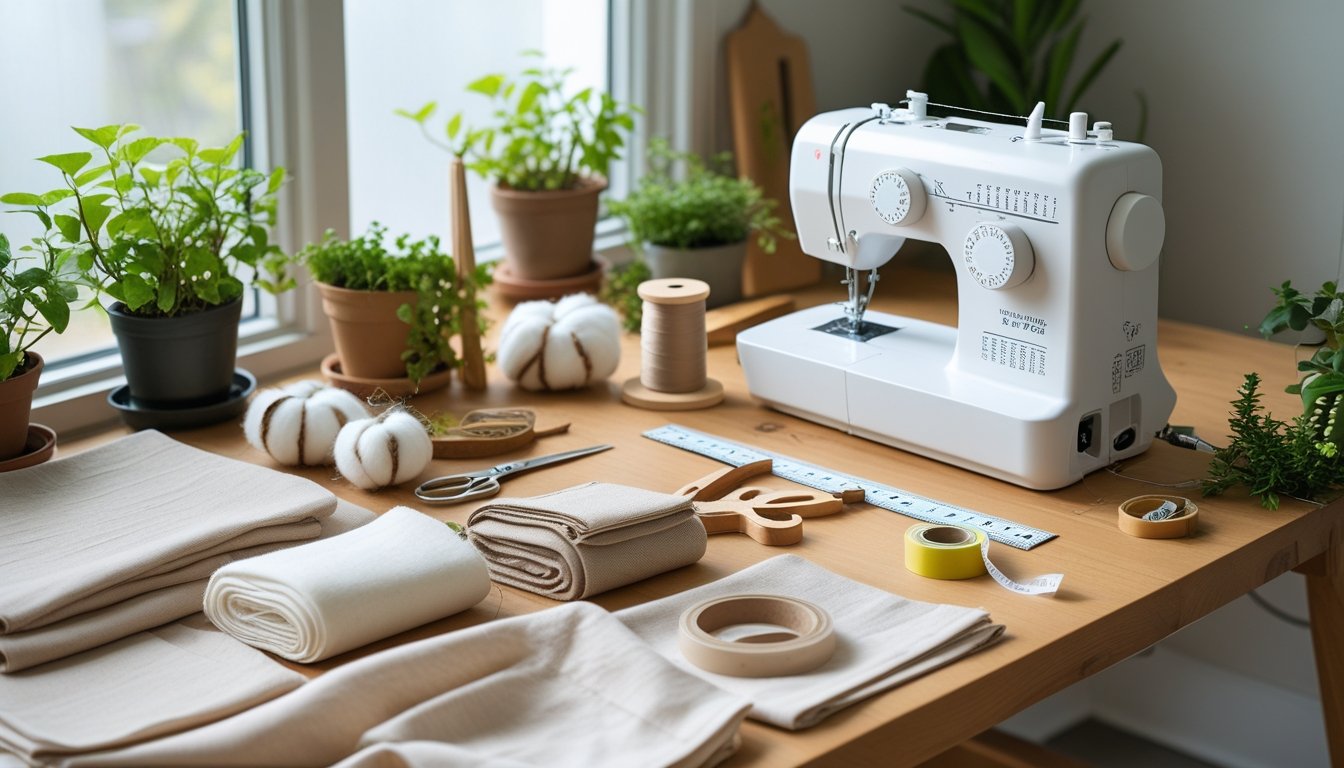Late updated: 01 Jul 2025 12:07
Written by: Sarah Hollister
Eco-Friendly Sewing Tips For Beginners: A Guide to Sustainable Crafting
Embarking on the journey of eco-friendly sewing can be both rewarding and vital for our planet. By making small, sustainable changes in our sewing habits, we contribute to reducing excessive waste while promoting creativity in innovative ways. Using eco-friendly materials and techniques connects us with a community of mindful creators dedicated to sustainability.

We can all find inspiration in transforming our sewing projects into zero-waste masterpieces. Whether substituting organic fabrics for conventional ones or opting for patterns that minimise fabric waste, there are numerous options for integrating sustainability into our craft. This approach not only helps the environment but also shakes up and energises our sewing experience.
Integrating eco-friendly practices within our projects empowers us with the awareness of our consumption patterns. This conscious choice encourages us to become more resourceful and creative, making sewing not only a hobby but a lifestyle that respects our planet.
Key Takeaways
- Eco-friendly sewing reduces waste and supports sustainability.
- Innovative patterns help minimise fabric waste.
- Conscious sewing enhances awareness of consumption patterns.
Getting Started with Eco-Friendly Sewing
Embarking on the journey of eco-friendly sewing can be rewarding as we focus on reducing our environmental footprint. From choosing the right fabrics to selecting sustainable tools, every decision impacts our commitment to a greener sewing practice.
Choosing Sustainable Fabrics
Selecting sustainable fabrics is an essential first step. Natural fibres such as organic cotton, linen, bamboo, hemp, and Tencel offer excellent options. These materials are produced with minimal environmental impact, often using less water and chemicals.
Recycled fabrics are another choice, as they repurpose waste materials, lessening landfill contribution. When considering wool, ensure it's sourced from ethical suppliers who prioritise animal welfare. By opting for these materials, we not only support sustainable practices but also enjoy the versatility and comfort they bring to our projects.
Essential Eco-Friendly Sewing Tools and Supplies
Eco-friendly sewing isn't just about materials; tools and supplies play an important role too. Recyclable metal tools such as scissors, needles, and stitch rippers reduce waste. Look for wooden or bamboo alternatives for items like rulers or cutting boards, which are biodegradable.
Using eco-friendly packaging for sewing supplies helps further reduce our environmental footprint. Aim to buy supplies in bulk to minimise packaging waste. Select threads made from natural or recycled materials to complement sustainable fabrics. Investing in quality, durable tools can save resources over time, as they require less frequent replacing.
Building Mindful Sewing Habits
Mindful sewing habits ensure we maintain a sustainable approach throughout our projects. Start by planning projects carefully to minimise fabric waste, utilising zero-waste sewing patterns whenever possible. Practice mindful consumption by only purchasing items needed for current projects.
Repurposing fabric scraps into smaller projects encourages creativity and reduces waste. Keeping an organised workspace can help prevent the unnecessary purchase of duplicated items. By consciously evaluating every step of our sewing process, we contribute to a more sustainable and eco-friendly craft.
Practical Eco-Friendly Sewing Tips for Beginners

By incorporating eco-friendly practices into our sewing projects, we can contribute positively to the environment. This involves utilising leftover materials, embracing upcycling methods, focusing on sustainable initiatives, and exploring natural dyeing techniques.
Utilising Fabric Scraps and Reducing Waste
Fabric scraps offer a chance to get creative while contributing to waste reduction. Instead of discarding small pieces, we can repurpose them into patchwork quilts or colourful embellishments for clothes. Employing a method known as zero waste sewing, we cut patterns with minimal waste or stitch scraps into new textiles like throw pillows or reusable makeup remover pads. Smaller scraps are perfect for stuffing homemade toys and cushions, ensuring every fabric piece finds its purpose, contributing to our commitment to sustainability.
Upcycling and Mending Techniques
Upcycling is a transformative process where we turn old or unused garments into new, stylish pieces. Thrift stores are excellent sources for finding pieces with potential. Simple techniques like adding patches to cover tears or using creative mending methods can extend the life of garments. Investing in skills such as darning socks or adding new buttons can save resources, leading to more durable garments. Personalising items through patchwork or embroidery not only revives them but also gives them a unique touch. Our approach to sewing can be empowering by making a positive environmental impact through mindful, resourceful practices.
Sustainable Sewing Projects for Everyday Use
Undertaking sustainable projects helps us develop practical skills while benefiting the environment. Reusable produce bags and bowl covers can substitute harmful single-use plastics. Making unpaper towels from old kitchen cloths offers an eco-friendly alternative to disposable towels. For those new to sewing, free sewing patterns online guide users through these straightforward projects. These efforts don't just provide functional items but foster an appreciation for reusability and the value of handmade goods.
Incorporating Natural and Plant-Based Dyes
Natural dyes are a superb alternative to synthetic ones, offering unique colours drawn from plants, fruits, and vegetables. We can experiment with easily sourced ingredients like onion skins or avocado pits, creating a range of beautiful, earthy tones. This process is environmentally friendly and avoids harmful chemicals, aligning well with sustainable objectives. Engaging in plant-based dyeing sharpens our understanding of natural resources and their incredible potential, encouraging further exploration and innovation within our crafting endeavours. It enhances our sewing projects with an organic touch, making each piece special and eco-conscious.
Frequently Asked Questions

In this section, we answer some common questions about eco-friendly sewing. We'll explore sustainable fabric choices, ways to incorporate upcycling, and techniques for reducing waste in sewing practices.
What are the best sustainable fabrics for novice sewers to use?
For beginners, opting for natural fabrics like organic cotton, linen, bamboo, and hemp is a great start. These materials are not only eco-friendly but also easy to sew. Choosing fabrics produced with minimal chemical intervention helps reduce environmental impact.
How can beginners incorporate upcycling in their sewing practices?
Upcycling involves transforming old textiles into new projects. Beginners can use old clothes or fabric scraps to create something fresh. Simple projects like tote bags, cushion covers, or scrunchies can rejuvenate worn materials, giving them a second life.
What techniques should a beginner adopt to minimise fabric waste?
To reduce fabric waste, beginners should first measure accurately before cutting. Pattern placement can also be optimised to use less fabric. Saving and repurposing fabric scraps for smaller projects or patchwork ensures every piece is used efficiently.
Can you suggest some eco-conscious sewing machine practices?
Maintaining your sewing machine helps it run efficiently and prolongs its lifespan. Use energy-efficient settings if available, and consider hand stitching smaller projects to save electricity. Keeping your machine clean and lubricated will support smoother operation and reduce the need for early replacement.
Where can one source ethically-produced sewing supplies?
Ethically-produced sewing supplies can be found through specialised retailers focusing on sustainable textiles. Many online shops offer ethically-sourced threads, fabrics, and tools. Look for certifications indicating fair trade practices and environmentally-friendly production methods.
What are the fundamentals of maintaining sewing tools for longevity?
Proper care extends the life of sewing tools. Store scissors and pins separately to prevent damage. Regularly sharpen scissors and replace needles to maintain precision. Keeping tools clean and following manufacturer care instructions preserves their functionality over time.
